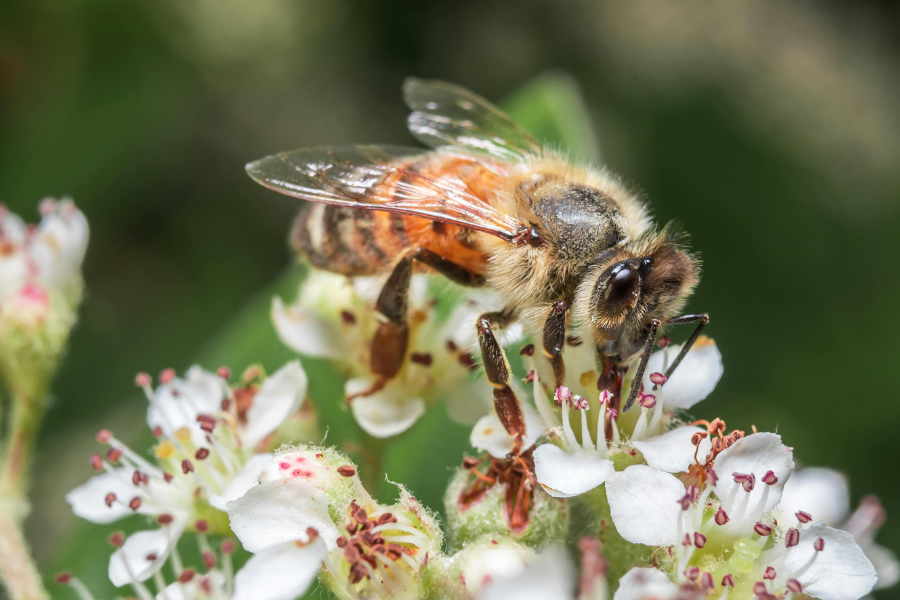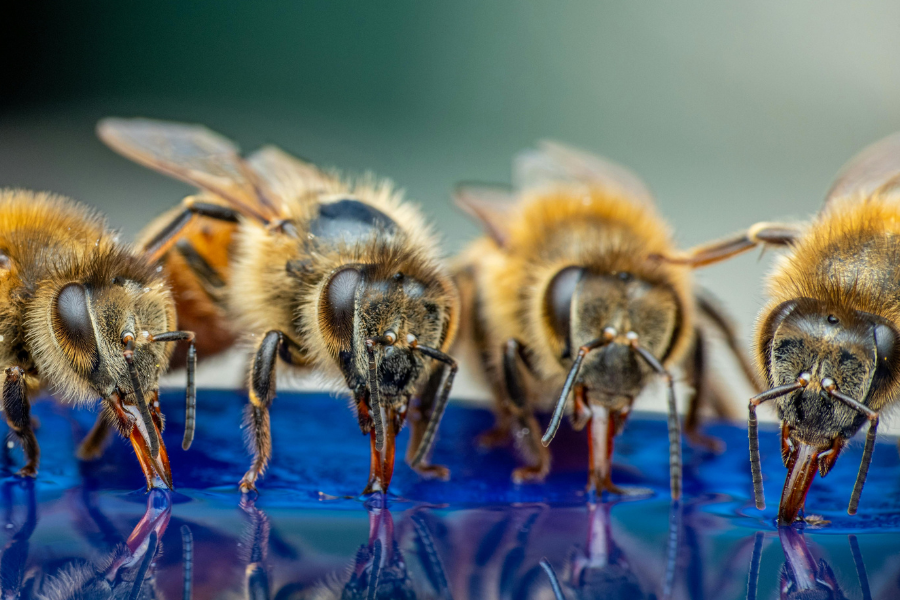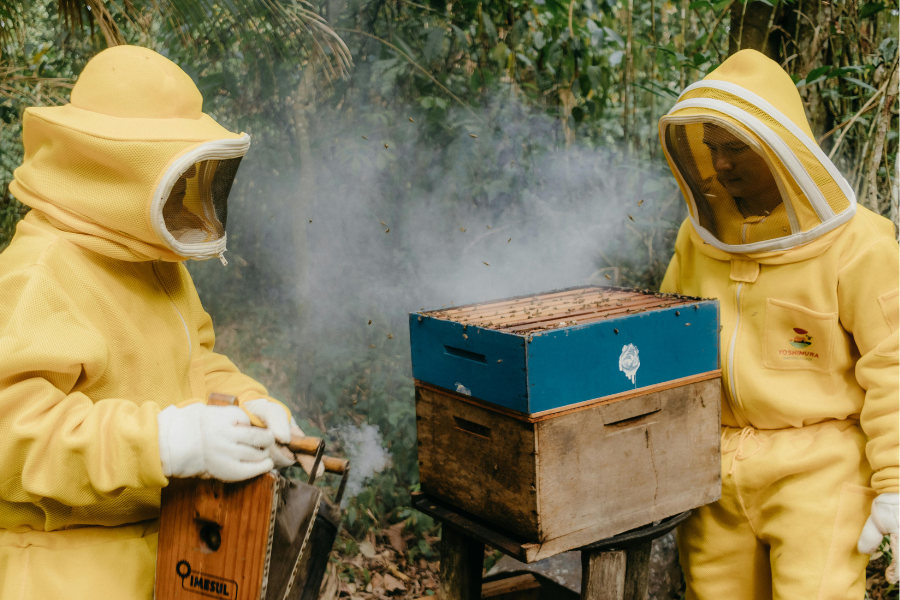Table of Contents
Introduction
Robbing behavior in honey bees can be a real headache for both new and seasoned beekeepers. When bees start raiding other colonies to steal honey, it’s not just chaotic—it can seriously weaken hives, trigger aggressive behavior, and even cause colonies to collapse. That’s why stopping robbing behavior is so important for keeping your hives strong and your bees thriving.
In this article, we’ll break down the best strategies to prevent robbing. From spotting the early warning signs to using tools like bee robbing screens, we’ve got you covered. Plus, we’ll share proven tips and answer common questions to help you keep your beekeeping journey on the right track.
1. What is Robbing Behavior in Honey Bees?
Definition of Robbing
Robbing occurs when bees from one hive invade another colony to steal its honey. This behavior often escalates during times of scarcity, such as late summer or drought periods, when nectar sources are limited.
2. What Does Honey Bee Robbing Look Like?
Identifying robbing is critical. Common signs include:
- Aggressive fights at the hive entrance, with bees grappling each other mid-flight.
- Dead bees scattered around the hive.
- Bees darting in and out of the hive frantically.
- Shredded wax combs inside the invaded hive.
3. Causes of Robbing in Bee Colonies
Several factors can trigger robbing behavior, such as:
- Weak or poorly defended hives.
- Excessive hive disturbance by the beekeeper.
- Feeding bees in an open or improper manner.
- Prolonged periods of nectar dearth.
4. Signs of Honey Bee Robbing
Physical Indicators
- Numerous bees attempting to force their way into the hive.
- Chewed or broken hive entrances.
- Honey dripping around the hive area.
Behavioral Patterns
- Increased aggression among bees.
- Persistent scouting activity around hive cracks or seams.
- Chaotic flight patterns near the hive entrance.

Strategies to Prevent Robbing Behavior
5. Strengthening Hive Security
Bee Robbing Screens
Bee robbing screens are a game-changer when it comes to preventing robbing. These clever tools let your resident bees come and go through a hidden pathway while throwing off would-be robber bees. In fact, research shows that hives with robbing screens face far fewer attacks from robbers.
Top Tip: Consider investing in high-quality robbing screens, like 10-frame or 8-frame options, to keep your hive entrances secure.
DIY Idea: Want to save money? You can make your own robbing screen using basic materials like mesh and wooden frames. It’s easier than you think!
Reducing Hive Entrance Size
Smaller hive entrances make it easier for guard bees to defend against intruders. Consider using entrance reducers during vulnerable periods.
6. Proper Hive Placement
Strategically placing your hives can deter robbing. Ensure your apiary:
- Is not overcrowded.
- Avoids direct exposure to strong wind or excessive sunlight.
- Maintains adequate distance between hives.
7. Avoid Attracting Robber Bees
Careful Handling of Honey and Feeders
- Never leave exposed honey or sugar syrup near your hives.
- Feed your bees inside the hive to minimize robbing risks.
Minimizing Hive Disturbance
Limit unnecessary hive inspections during robbing-prone seasons to reduce stress on your colonies.
8. Emergency Responses During Robbing
Using Robbing Screens Effectively
Install robbing screens immediately when robbing signs appear. Ensure proper placement to allow resident bees access to the hive.
Blocking Hive Entrances Temporarily
In severe cases, use wet sheets or grass to block hive entrances temporarily. This disrupts robber bees while giving your colony time to regroup.
9Studies Supporting Robbing Prevention Strategies
Effectiveness of Robbing Screens
Research shows that robbing screens reduce robbing incidents by up to 70%, making them a must-have for any beekeeper.
Impact of Hive Strength on Robbing Incidents
Stronger colonies with abundant guard bees are less likely to be targeted by robbers. Regularly inspecting and strengthening your hives can significantly lower robbing risks.

Prioritize Hive Strength to Deter Robbers
- Focus on enhancing colony health with probiotic supplements to boost immunity and defensive behavior.
- Use natural stimulants like essential oils in syrup feeders to improve productivity and reduce robbing tendencies.
- Conduct regular inspections to address vulnerabilities such as weak queens or damaged combs, which can attract robbers.
- Strengthen hive guard populations by ensuring consistent access to high-quality protein sources like pollen patties.
10. Decoy Hives: A Strategic Defense
- Set up decoy or bait hives filled with honey or left empty to divert robbing activity away from productive colonies.
- Position decoy hives at a safe distance from your apiary to act as a buffer zone.
- Monitor these decoys regularly to study robbing patterns and identify problem areas within your beekeeping environment.
- Scale this strategy for larger operations by placing decoy hives in strategic locations across your apiary.
Seasonal Hive Management Practices
- During late summer and fall, install entrance reducers to limit access points and make invasion harder for robber bees.
- Ensure proper hive ventilation to reduce congestion and stress near entrances, minimizing robbing triggers.
- Rotate hive placements within the apiary periodically to disrupt robbing patterns and confuse foragers.
- Plan for seasonal nectar shortages by supplementing colonies with food sources to reduce competition and robbing risks.
Key Insights on Preventing and Managing Robbing in Honey Bees
Robbing Behavior: What It Is and What Triggers It
Robbing happens when bees from one hive invade another to steal honey—usually because there’s not enough nectar in the environment. Weak hives are especially at risk, particularly during times of drought or when nectar sources are scarce.
Aggression and Hive Vulnerability
Robber bees don’t hold back—they’re extremely aggressive and often clash with guard bees at the hive entrance. These battles can lead to severe losses, including the death of the queen, which can destabilize the entire colony.
Spotting Robbing: Signs and Duration
If you notice frenzied activity at the hive entrance, bees fighting in mid-air, or chewed combs, you’re likely dealing with robbing. It can last anywhere from a few hours to several days, but if left unchecked, it can devastate weaker colonies in no time.
The Sneaky Threat of Silent Robbing
Silent robbing is even trickier. This happens when intruder bees sneak honey out of a hive without triggering any major aggression, making it much harder to detect. That’s why regular hive inspections are key to catching it early.
How to Prevent Robbing
Stopping robbing starts with a few simple steps:
- Reduce Hive Entrances: Especially during nectar shortages, smaller entrances are easier for guard bees to protect.
- Avoid Open Feeding: Never leave honey or syrup exposed—it’s like sending an open invitation to robbers.
- Ensure Adequate Food: Providing enough resources for your colonies helps reduce their urge to rob.
Robbing Screens: Your Hive’s Best Defense
Robbing screens are a lifesaver. These screens change the hive’s entrance path, confusing robber bees while still allowing your own bees to come and go freely. Whether you go for a commercial option or make your own, robbing screens are a simple yet powerful solution.

What to Do During an Active Robbing Attack
If robbing breaks out, act fast:
- Throw a Wet Sheet Over the Hive: This temporarily blocks entrances and calms things down.
- Install Robbing Screens: These can help stop the attack and protect your hive moving forward.
- Strengthen Weak Hives: A stronger hive is less likely to be targeted in the future.
Keeping Your Bees Safe
By understanding robbing behavior and using smart tools like robbing screens, you can protect your hives and keep your colonies healthy and thriving. It’s all about being proactive and ready to respond when needed!
Utilizing Natural Deterrents and Behavioral Training to Prevent Robbing
While physical tools like robbing screens and entrance reducers are effective, natural deterrents can be just as powerful in preventing robbing behavior:
- Essential Oils: Use oils like lemongrass and peppermint in feeders or around hive entrances to confuse and repel robber bees.
- Behavioral Training: Introduce new foraging patterns to your bees by regularly changing forage locations. This helps divert attention from nearby hives and reduces the temptation for robbing.
- Diverse Foraging Areas: Plant a variety of forage-friendly plants around your apiary to naturally reduce the chances of your bees raiding other colonies, while boosting their overall foraging behavior.
These methods not only strengthen your colony’s defenses but also enhance their health by encouraging natural, diverse foraging.
Creating a Robbing-Free Environment with Strategic Apiary Layout
The layout of your apiary plays a crucial role in minimizing the chances of robbing:
- Buffer Zone with Plants: Plant tall shrubs or trees around your apiary to shield hives from external stressors and discourage robbing bees.
- Longer Flight Paths: Position your hives in a way that forces bees to fly longer distances when returning home, making it more difficult for robbers to follow.
- Stagger Hive Locations: Place hives at different distances from each other, making it harder for robbing bees to locate and target multiple weak colonies at once.
These strategic layout changes create confusion for robber bees, improve hive security, and contribute to a healthier, more secure apiary.
Comprehensive Solutions for Protecting Your Hive from Robbing
- Robber Bee Funnel Trap: Set up a funnel trap made from mesh or plastic near hive entrances. This trap funnels robbing bees into a container where they can’t escape, preventing them from reaching the hive. It’s a simple yet effective method to reduce robbing activity
- Artificial Pollen Substitutes: Use during nectar dearth periods to reduce food competition, making your bees less likely to raid other colonies.
- Strong Colony Health: Regular mite treatments and early spring feeding strengthen your colonies, making them more resilient and less prone to attracting robbers.
Unique and Commercial Solution-Based Points
Showcase Modern Innovations in Robbing Prevention
- Highlight advanced robbing screens: Mention commercially available, innovative robbing screens such as the Bee Smart Robbing Screen or custom-fit options for 8-frame and 10-frame hives.
- IoT-enabled hive monitors: Discuss the latest technology that alerts beekeepers to abnormal hive activity, including robbing signs.
Provide DIY Options with Commercial Value
- Step-by-step guide for DIY robbing screens: Offer a unique DIY plan for making robbing screens, including a shopping list for materials from popular hardware stores.
- Cost comparison: Show readers how much they can save with DIY solutions versus purchasing pre-made robbing screens.
Focus on Hive Strength as a Commercial Strategy
- Recommend protein supplements or pollen patties to boost colony health and reduce vulnerability to robbing.
- Suggest partnering with local suppliers for bulk bee feed, benefiting commercial beekeepers managing multiple hives.
Offer Emergency Kits for Robbing Situations
- Create a checklist for an anti-robbing kit including robbing screens, hive reducers, wet sheets, and smoker fuel. Promote links to affiliate products for easy purchase.
Seasonal Robbing Prevention Packs
- Suggest tailored solutions for different seasons, such as summer robbing prevention packs that include robbing screens, feeders, and entrance reducers. Link to curated packs sold online.
Incorporate Scientific Evidence with Commercial Products
- Present findings from studies on the effectiveness of commercial robbing screens and hive tools. Include affiliate links to products mentioned.
Beekeeper Stories and Testimonials
- Share success stories of beekeepers who used specific products like anti-robbing screens or hive entrance reducers. Highlight how these solutions saved their hives.
Offer Exclusive Discounts or Resources
- Partner with beekeeping product suppliers to offer exclusive discounts for your readers. For example, “Get 15% off on robbing screens with the code ‘BEECARE15.’”
- Provide printable resources, such as a “Robbing Prevention Checklist.”
Educational Add-Ons
- Add a downloadable infographic on robbing behavior that explains signs, prevention, and emergency actions.
- Offer a free mini-course or eBook, “How to Master Robbing Prevention in Beekeeping,” to build engagement and trust.
Community Engagement and Feedback
- Encourage readers to share their unique robbing prevention tips in the comments or through social media hashtags like #HiveProtectors.
- Create polls or surveys asking readers about their biggest challenges with robbing and offer personalized advice in future content.
Conclusion
Preventing robbing is all about keeping your bees happy and your hives safe. Simple steps like using robbing screens, tweaking hive entrances, and making sure your colonies stay strong can go a long way. Take care of your bees, and they’ll reward you with thriving hives season after season!
Frequently Asked Questions
What is bee robbing?
Bee robbing occurs when bees steal honey from other colonies, usually during nectar shortages.
How do I identify robber bees?
Robber bees are often aggressive, darting in and out of hives, and engaging in fights with resident bees.
What’s the best way to stop honey bee robbing?
Using bee robbing screens and reducing hive entrances are highly effective methods.
Can robbing screens be used on any hive?
Yes, robbing screens come in various sizes, such as 10-frame or 8-frame options, suitable for most hives.
Do bees fight at the hive entrance during robbing?
Yes, fights at the hive entrance are a common sign of robbing behavior.






Here, you can access a wide selection of slot machines from top providers.
Users can experience traditional machines as well as feature-packed games with vivid animation and bonus rounds.
Whether you’re a beginner or a casino enthusiast, there’s always a slot to match your mood.
slot casino
Each title are instantly accessible anytime and designed for PCs and tablets alike.
You don’t need to install anything, so you can start playing instantly.
The interface is easy to use, making it simple to find your favorite slot.
Register now, and enjoy the thrill of casino games!